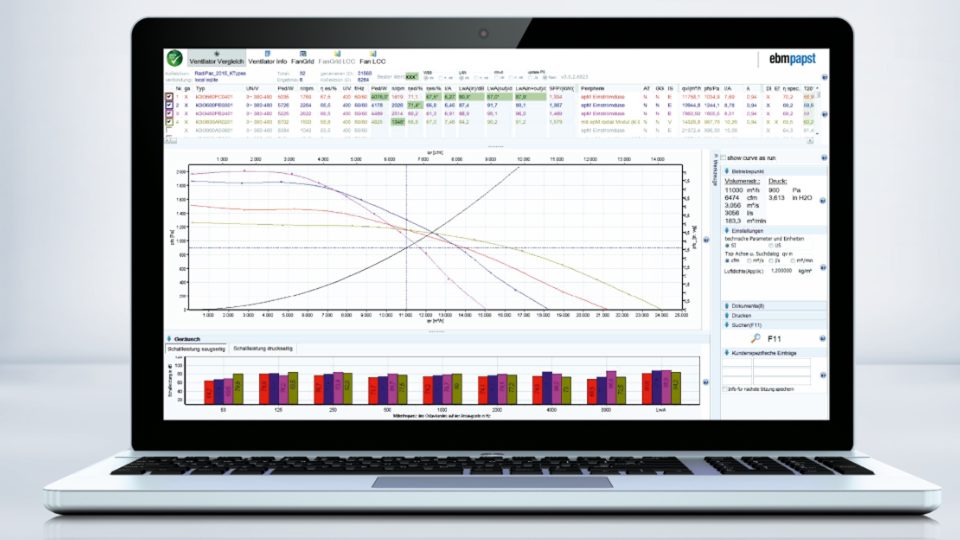For some time now, motor and fan specialist ebm-papst has been employing a continuous improvement process in fan technology. In recent years, the centrifugal fans in the RadiPac series, specially designed for use in air conditioning and ventilation units, have been constantly optimized, with particular emphasis on energy efficiency, noise reduction, and easy handling.

With the new RadiPac C Perform fans, we have now succeeded in improving this successful series yet again. Special air-conducting modules now increase the efficiency by up to 5 percent, while the proven support brackets have been retained (Fig. 1).
This means that the mounting dimensions and mounting hole patterns remain identical, so practically no design changes are necessary in the application to benefit from the higher efficiency levels and lower current consumption.
Air guide modules increase the efficiency
Air guide modules reduce outlet losses in the RadiPac C Perform fans. With free-blowing fans, these are often underestimated energy guzzlers, as the impeller drive power Po is divided into the static delivery rate that can be used for the user (Pus = product of air flow and static pressure increase of the fan) and the different losses that occur during the conversion.

Here, the greatest loss factor is the dynamic power component (Pud) of the air performance, which is also referred to as the outlet loss. It is made up of the product of the air flow and the dynamic pressure. To minimize these losses, ebm-papst has developed a housing for the RadiPac, consisting of four segments.
The module segments are made of galvanized sheet steel and have an aerodynamic shape. This special shape slows down the flow speed, which reduces the dynamic pressure component and increases the usable static pressure component (Fig. 2). In addition, the new flange plate was turned 15 degrees and provided with recesses at the flow outlet, which also helps to reduce exit losses. At the same operating point, for example, the fans can run at a lower speed, which in turn means that less energy is required (Fig. 3).

Fan selection made easy thanks to FanScout
Whether users opt for the new RadiPac C Perform fans with air guide modules or the tried-and-tested versions with open support bracket depends on several factors. In both RadiPac designs, highly efficient GreenTech EC motors are used as a drive and the shape of the five-blade impeller meets the latest aerodynamic criteria. The efficiency of the external rotor motors fulfills the requirements for efficiency class IE5 set in IEC/TS 60034-30-2. For system efficiency, the drive system, consisting of motor and integrated power electronics, is individually adapted on each fan, and is optimized for the relevant operating range.
FanScout determines the most economical fan solution based on application-specific operating points and the expected operating times.
Which RadiPac variant ultimately pays off more for the user depends primarily on the type of use and duration, the required air performance, the desired speed range and the pressure ratio of the application. However, the FanScout selection program makes it easy to choose the right one.

The selection software (Fig. 4) identifies the most economical fan solution, using up to five application-specific operating points and the expected operating times. The amount of installation space available, maximum number of fans required and redundancy requirements can also be taken into account. To make the evaluation of the various options even more useful to the user, FanScout also has a function that identifies the life cycle costs of the combination under consideration.
This involves multiplying the power consumption of the fans at each operating point by the operating time and electricity costs, and adding up the total. The result represents the pure operating costs of the installation over a specified period. After you enter the costs for the purchase, installation and service, the overall costs over time are displayed. This provides users with a realistic cost assessment and a reliable basis for their investment decisions.
Automatic resonance detection for more operational reliability
Centrifugal fans are used in a wide range of applications. Depending on the installation situation, resonance can occur in unpredictable speed ranges. If the fan is often operated in such critical ranges, the drive motor’s bearing system may be damaged, leading to premature fan failure. Although these vibrations can be measured for system operators, they cannot simply be eliminated. ebm-papst solves this problem with RadiPac and RadiPac C Perform centrifugal fans using automatic resonance detection, which avoids operation at critical speeds, increasing the service life and operational reliability.

In addition, a test start-up can be performed during commissioning in which the vibration speed is analyzed over the entire speed progression from standstill to nominal speed. If excessive vibration speeds are detected in certain areas, the control software adjusts itself after activation by the customer so that these speed ranges are “passed over” in the future. This means that the ranges are passed through, but continuous operation in them is avoided (Fig. 5). Operators can manually edit the software settings at any time, meaning that they always have full control.
The energy-saving RadiPac C Perform fans with air guide modules in support bracket are currently available in seven sizes (BG 280 to BG 630) and with outputs of up to 8 kW. Versions without air guide modules are available in the same sizes with motor powers from 85 W to 8 kW.
Read more about the FanScout:
The simplest way to the best result
You supply the requirements of your application, FanScout the suitable fan.

Leave a comment